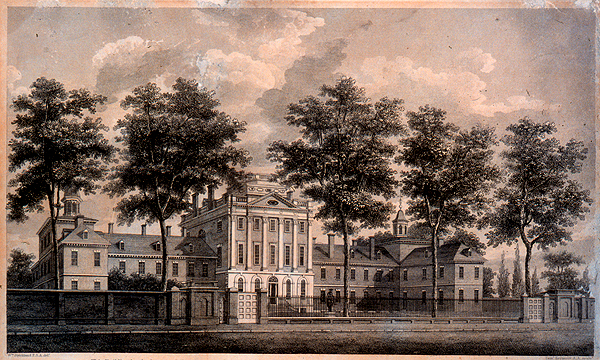- Pennsylvania Hospital
Infobox_nrhp | name =Pennsylvania Hospital
nrhp_type = nhl

caption = The Pennsylvania Hospital by William Strickland (1755)
location= 8th and Spruce Sts.Philadelphia, Pennsylvania
lat_degrees = 39
lat_minutes = 56
lat_seconds = 41.2
lat_direction = N
long_degrees = 75
long_minutes = 9
long_seconds = 22.56
long_direction = W
locmapin = Pennsylvania
area =
built =1756
architect=Samuel Rhoads
architecture= No Style Listed
added =October 15 ,1966
governing_body = Private
refnum=66000688cite web|url=http://www.nr.nps.gov/|title=National Register Information System|date=2007-01-23|work=National Register of Historic Places|publisher=National Park Service]Pennsylvania Hospital ("Pennsy") is a
hospital inCenter City, Philadelphia currently affiliated with theUniversity of Pennsylvania Health System ("Penn Health System"). Founded in 1751 byBenjamin Franklin andDr. Thomas Bond [ [http://www.archives.upenn.edu/histy/features/1700s/people/bond_thomas.html Thomas Bond] at Penn Archives] , it was the first hospital in theUnited States .History
In 1752, the first (temporary) building was opened on High (now Market) Street. Elizabeth Gardner (a
Quaker widow) was appointed Matron.In 1755 the cornerstone was laid for the East Wing of what would become the hospital's permanent location at 8th and Pine Streets. Patients were first admitted to the permanent hospital in 1756. The site continued to grow through the years with the addition of more wings (such as the West Wing of the building which was built in 1796) and buildings, extra land and further expansion.
Care of the mentally ill was removed to
West Philadelphia in 1841 with the construction of the Pennsylvania Hospital for the Insane, later known asThe Institute of the Pennsylvania Hospital . Under superintendentThomas Story Kirkbride , the hospital developed a treatment philosophy that became the standard for care of the insane in the 19th century.Pennsylvania Hospital gained a reputation as a center of innovation and medical advancement, particularly in the area of maternity. In its early years it was also known for its particularly advanced and humane facilities for
mentally ill patients (at a time when mental illness was very poorly understood and patients were often treated very badly).In 1950 Pennsylvania Hospital was recognized for becoming more highly specialized as it established, in addition to its sophisticated maternity programs, an intensive care unit for
neurological patients, acoronary care unit, anorthopaedic institute, adiabetes center, a hospice, specialized units inoncology andurology and broadened surgical programs.The hospital was also a center through the years for treating the war wounded. Patients were brought to the hospital for treatment in the
Revolutionary War , theAmerican Civil War and theSpanish American War , and units from the hospital were sent abroad to treat wounded inWorld War I and inWorld War II (to the Pacific theater).The seal of the hospital, chosen by Franklin and Bond, incorporates the story of the
Good Samaritan and the phrase "Take Care of Him and I will repay Thee" is used on it.In 1997 Pennsylvania Hospital's Board of Managers made the decision to merge with the Penn Health System. The large Health System helps to support the formerly stand-alone hospital with its vast network of resources.
In 2001 Pennsylvania Hospital celebrated its 250th anniversary. It continues to be a center of innovation and excellence in medicine.
The library
In 1762 the first book for the hospital's Medical Library was donated by Dr. John Fothergill, a British friend of Franklin's. The library would continue to grow and in 1847 the
American Medical Association designated the library as the first, largest, and most important medical library in theUnited States . It is still a repository for historic books and journal collections, with works dating from 1483 to 1930.Famous physicians
* Dr.
Benjamin Rush . On staff from 1783 until 1813, he was a medical teacher, a social reformer, and a signer of theDeclaration of Independence .
* Dr.Philip Syng Physick . On staff 1794 until 1816. He achieved fame through his surgical prowess.Maternity
Pennsylvania Hospital is especially noted for its many firsts in the area of women’s medicine, especially in the specialty of maternity.
In 1803 the hospital established a "lying-in" (or maternity) department. This lasted until 1854 when
obstetrics andgynecology took a 75-year break at the hospital. The specialties were reinstated in 1929 with the opening of the Woman’s Building (now the Spruce Building) which sported 150 adult beds, 80 bassinets, 2 operating rooms, a series of labor and delivery rooms, and outpatient clinics. It was considered "one of the most modern hospital buildings in the country" especially at a time when women’s medicine was not thought to be very important and most births were still done at home.This was followed in 1978 with the first
Antenatal Testing Unit (ATU) in the region and in 1985 when the first GIFT (Gamete intrafallopian transfer ) pregnancy in Philadelphia was achieved at the hospital. In 1987 Pennsylvania Hospital had two obstetrical firsts: the first Birthing Suite in a tertiary care hospital in the state was opened, and the firstgestational carrier andegg donor programs in theDelaware Valley were begun to complement the hospital's existing fertility services. In 1995 the hospital was the first in the region to achieve 1,000 live births fromin-vitro fertilization ,GIFT and other assisted reproductive technologies.References
ee also
*
Hospital of the University of Pennsylvania ("HUP") - A separate hospital also affiliated with the Penn Health System.External links
* [http://www.pennhealth.com/pahosp/ Pennsylvania Hospital, University of Pennsylvania Health System]
* [http://pennhealth.com/bloodless/about.html Bloodless Medicine & Surgery Center, Pennsylvania Hospital]
Wikimedia Foundation. 2010.
